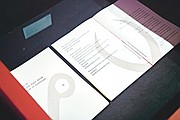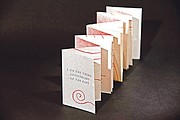By DR IAN BETHELL-BENNETT
The lingering impact of violence is long and cross-generational. The Bahamas, as has been repeatedly discussed, is a society steeped in violence, especially violence against women. Officialdom, however, chooses to dismiss this violence as something unimportant, socially insignificant and someone else’s problem. The tragedy of this attitude to violence and sexual violence, is that it has become endemic to our social structure and that it permeates all levels of society. Recent gaffs about rape and sexual violence have landed us right back here.
It is even more timely that as a part of the ninth National Exhibition at the National Art Gallery of the Bahamas two artists have created an installation of spoken and written word titled “The Red Thread Cycle” that explores the awful, haunting impact of sexual violence and rape. As the Minister for Social Services extricates himself from a controversy caused by “insensitive” remarks he made in response to the increase of rape cases in the country, we understand that as society fails to address the serious and deepening social ills, we are only going to dig a deeper hole for ourselves. Firstly, sexual violence cannot and will not be cured through policing. Policing denies and, at times, worsens rape culture.
Sonia Farmer and Shivanee Ramlochan’s work is horribly haunting and deeply impactful. Their haunting verse and colour resides in the memory of the viewer long after having left the exhibition. It draws attention to the serious and social silence around sexual violence. Yes, we discuss it, but we discuss it as if it did not happen and as if it had no lasting impact. We discuss it from a patriarchal misogynistic perspective that blames the woman or man who is raped or sexually assaulted and exculpates the violator. This is also seen with R Kelly’s case and how society in fact encouraged his violations of young women. Predators are made through silence and permissiveness. When we turn a blind eye to rape, incest and all forms of sexual violence, which includes child prostitution by mothers pimping daughters and sons, we promote a culture of rape and violence.
Red is an impactful colour. And rape is an impactful act that lingers in the body and mind of the victim. Colour is lasting in the mind’s eye. The vastness of experience is consumed by the blanket of deep, rich and devouring shades of suffering, shocking pink and red that inscribe themselves into our mind’s eye, deep blue and plum purple, of bleeding wounds that open from punches inflicted from so-called love, and swallow our pleasure in deep wells of trauma. The wicked of the past shall not be forgotten by the whitewashing of historical dalliances and cosmic battles of sexual devastation that continually bring us back to gathering bones as we sit with our suffering in prosperity’s silence. Our silence only brings deeper decay as in small communities where teenage pregnancy often results from incestuous relationships that many women blame on “dem hot young gyals”. They never stop to ask, who made them thus.
The first impression of “The Red Thread Cycle” is lingering. It is a hard pill to swallow. Meanwhile, government and people understand that the Bahamas ranks among the highest in the region for sexual violence. Rape and all forms of sexual violence have become a national problem, yet these are often ignored. Even the point of discussing marital rape is now laughed at and referred to as a private matter between husband and wife or dismissed as being less important than cooking stew(ed) fish.
The artist and poet collaborate on this work to produce a truly haunting and deeply distressing piece that throws off the cover of the violence of forced sexual encounters. Ironically, the nation sees this as a normalised aspect of being, that women should expect to be harassed by male sin society. Further, they must watch what they wear because their clothes somehow justify or call out to any man to attack and then excuse him for doing so. It is against this backdrop of normalised and naturalised violence against women and predatory masculinity that these artists produce this disturbing work for the ninth annual National Exhibition.
Art and artistic expression often allow boundaries between spoken and unspoken to be crossed. I see this as no exception as the work truly explodes the idea that rape or sexual trauma is anything other than violence. The colour, the texture, the mapping of the written word on paper, made by Farmer, are sufficient to demonstrate how truly devastating sexual violence is. Red etched into paper, strewn with more red and folded in on itself or even laid bare all speak to a violence of rupture and penetration that disavow the gentle aspect society play to sexual violence, except when they themselves become victims. Red splashes across the page, much like blood escaping the body, forced into violent submission; the graphically harsh words of tear and force sound loudly in the ears of the listener in this multimodal and polysensory installation.
To tear at the seams of one’s sex is to do violence to someone that will be lived and relived for that person’s existence, yet it is belittled, dismissed and laughing talked about as she looked for it. The violence in this dehumanising and denial of the initial violent attack is doubling.
So much of patriarchal society, seen through the work of Farmer and Ramlochan, encourages unwanted sexual advances of hypermasculine men towards sexualised women who are supposedly there exclusively for male enjoyment. The work sounds alarm bells that are often muffled by officialdom’s refusal to see or accept the significant and devastating national impact of sexual violence against children and women. Silence is golden when it comes to sexual violence because to state that one has been raped results in twice being raped, once by the attacker and the second time by a system that is dehumanising and exploitative. Yet this continues even as more women rise to positions of power where they speak for, but more importantly over women who they are elected to (re)present.
Unlike much of patriarchal, state language, Farmer and Ramlochan’s language is measured and the text clear and unflinching. It is not rushed or slapdash, but truly painstakingly metered out on the page and through the vocalised articulation of the poet. Denial is overthrown, disavowal is shown for what it is, the corruption and perversion of justice by a masculine gaze that refuses to see feminised bodies as anything other than objects of exploitation. Not every woman walking simply wants a man. Society has taught its men that they can take whatever woman they want and so impose their damaged masculinity on any female body. The damage from and legacy of slavery plays out daily in this postcolonial period, encouraging more men like the man the documentary “Surviving R Kelly” depicts.
The piece is very empowering of the body afflicted by unwanted violence, though the system often claims otherwise. Art allows women to open the discussion to how many ways and how profoundly they are hurt by masculine exploitation and sexual violence. It allows them to speak in their own terms, to empower their own voices to throw off the mantel of silence imposed by respectability and the politics of Victorian Madonna-esque virtue that allowed, indeed encouraged, so much sexual violence and rampant dehumanisation through bodily conquest. Some women continue to claim that other women will get over it when they are sexually attacked or made victim to unwanted sexual advances or incest. Again, this is a social problem that is often swept under the rug and remains a factor in small, close-knit communities where fathers turn out their daughters and mothers remain tight-lipped about the level of familial dysfunction.
As a society – and this seems very present in the work – we have survived slavery and emancipation. But the emasculation of black men through slave-master privilege has led to lasting legacies of internalised violence and intergenerational and cross-generational repetition of patterns. In this society, violence is real. These legacies promote surreal abuse and sexual violence, but when explored through the pathology of slavery and survival of trauma, we understand the trauma that is visited not just on the physical body but also on the emotional and spiritual body of those beings. This trauma is similar to a cultural fear and loathing of dogs that stems from dogs being used to hunt and destroy enslaved Africans or to torture them in the fields. This violence remains resident in the body of the descendants of those who survived slavery and can result in strange sexualised patterns of behaviour.
“The Red Thread Cycle” is a timely intervention in a national debate; though horribly haunting and disturbing it opens a discussion of the level of violence resident in our small communities. It also speaks to the legacy of sexual violence across the Caribbean from the Bahamas all the way to Trinidad. We may picture this work as too troubling to be productive as needing to be silenced, but the catharsis of speaking out to claiming one’s story, one’s voice and reclaiming one’s strength. The work stays in memory. When will society change its approach to violence.








Comments
Use the comment form below to begin a discussion about this content.
Sign in to comment
Or login with:
OpenID